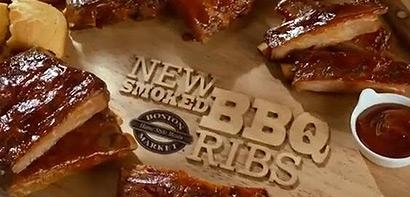
The
major success of Boston Market's St. Louis Style ribs obviously reflects America's love affair with a good rib at the right price. But as always, marketing helped.
Boston Market
just announced that the ribs, launched in April and positioned as a limited-time offering, have been added to its permanent menu.
Not surprising, given that the chain's sales
are up 16% since the ribs launched, and its overall transactions were up 8% in April and May. Meals with ribs now account for 18% of all transactions, on average (as much as 25% in some markets) --
versus Boston Market's original goal of 8% for the new product's first eight weeks.
Moreover, customers are paying $10.99 for a quarter rack of ribs, or $12.99 for either a
half-rack of ribs or a combo ribs/chicken meal, versus the $8.50 they would pay for a half chicken. (The ribs/chicken combo meal accounts for nearly half of all rib orders.)
advertisement
advertisement
The ribs have pushed Boston Market's check size up "significantly," and "fundamentally changed [its] structure," chief brand officer Sara Bittorf tells Marketing Daily.
The back story: Boston Market, which says it "invented" the fast-casual restaurant format 27 years ago, competes not only in that category, but against fast-food and casual dining
restaurants, Bittorf says. The brand -- which since 2011 has pulled off a turnaround through an "America's Kitchen Table" refresh spanning remodels and menu and service revamps -- viewed the rib intro
as a crucial opportunity to differentiate itself by offering ribs with casual-dining quality, at a fast-casual price point, she says.
From a marketing standpoint, the objective was,
of course, to drive awareness and sampling. "We knew that once people tried the ribs, frequency would take care of itself," Bittorf notes.
Since Boston Market has also been
seeking to "be a part of the popular culture again," she says, the launch strategy's promotions tied into tax day. In addition to a "Rib-bate" offer good only on April 15 (two ribs meals for $10.40),
there was a random giveaway of 1,040 Boston Market gift cards (entrants received a $1 coupon for a ribs meal, as well as a chance to win one of the $25 cards).
Tax-day sales were
"huge," helped by public relations/media outreach, as well as Boston Market's Facebook and Twitter promotions and friends sharing about the Rib-bate on social media, Bittorf reports. More than 230
local television stations mentioned the Rib-bate as part of tax-day deals stories.
The chain also diverged from its traditional local-TV-only advertising strategy. It invested in
15- and 30-second ads that aired on national cable, as well as local spot TV in key markets, between April 8 and May 12.
The campaign also included a full-page FSI buy offering a
$2-off coupon, Web banner ads, search-engine marketing, emails to Boston Market's VIP loyalty club members, and point-of-purchase promotions.
Employees' enthusiastic support has
been equally important, Bittorf says. Prior to the ribs' launch, the company's top executives flew around the country to reinforce to all employees how critical the launch (its first in six years) was
to the brand, she reports.
Encouraged to come to the meetings with some ideas to support the launch, employees came up with poems, an original ribs rap and an original song, among
many other creations -- some of which are now featured on a dedicated "Ribs-piration" page on BostonMarket.com.
"Employees were 100% confident and excited about selling the ribs" through suggestions, as well as reinforcing customers' ribs orders, Bittorf says.
Come fall,
Boston Market will run a TV and social campaign promoting that the ribs are now here to stay. "We've had a lot of input from customers asking us to keep them on the menu, so our approach will be 'You
asked, we listened,'" Bittorf says.
Boston Market has seen 34 consecutive months of positive same-store sales. Average same-store sales were up 6.5% in 2012 and 8.5% in
2011.
The chain currently has more than 460 U.S. locations, down from 630 in 2007. However, it's now planning new store openings for the first time in six years.